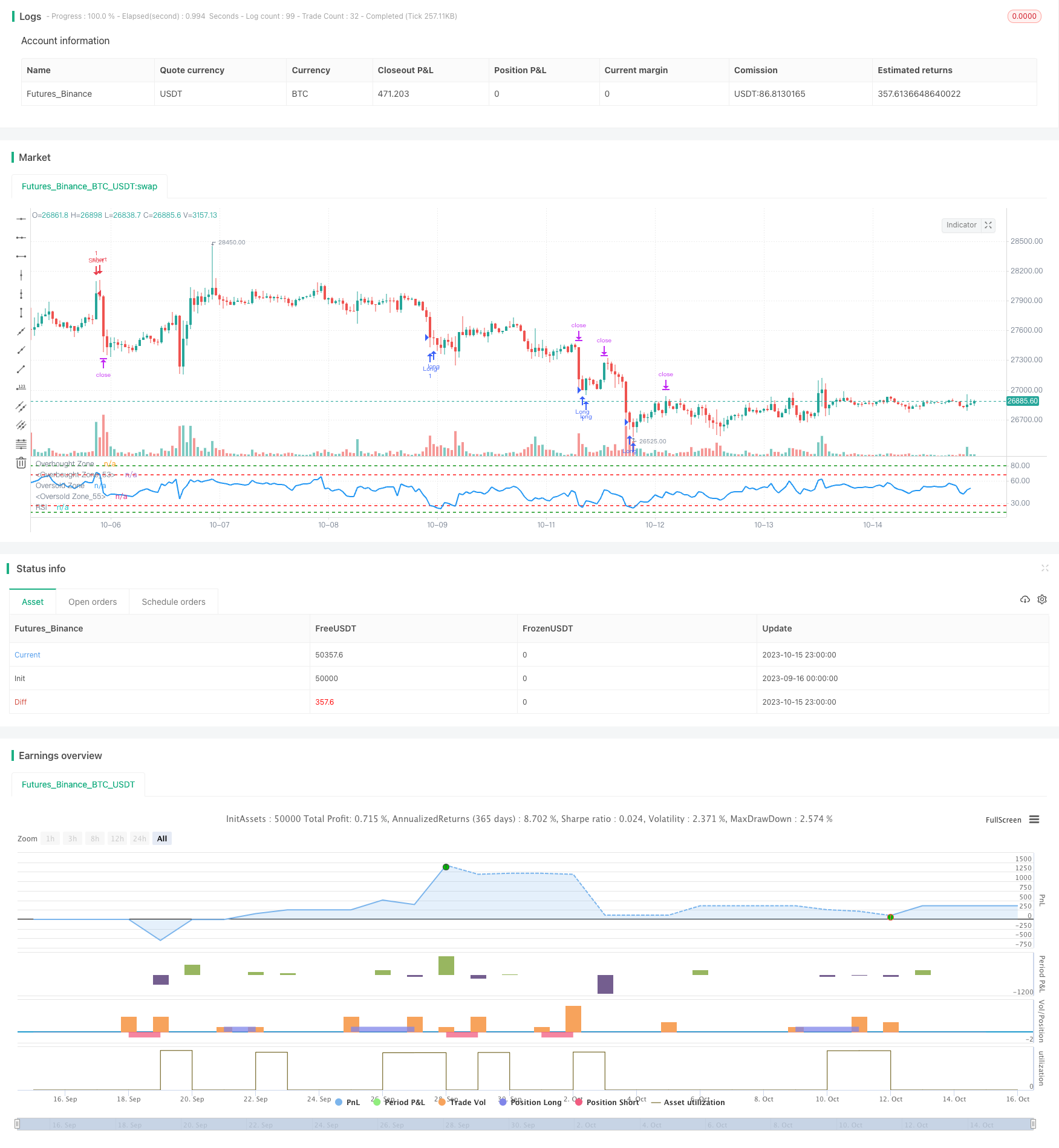
概述
本策略通过监控RSI指标在不同区间的突破,实现低买高卖的目的。当RSI位于低位区间时买入,当RSI位于高位区间时卖出,从而在超买超卖现象出现时进行反向操作。
策略原理
设置RSI的长度为14周期
设置买入信号的RSI区间:
- 区间1: RSI <= 27
- 区间2: RSI <= 18
设置卖出信号的RSI区间:
- 区间1: RSI >= 68
- 区间2: RSI >= 80
当RSI进入买入区间时,做多入场:
- 如果RSI进入区间1(27以下),做多1手
- 如果RSI进入区间2(18以下),额外做多1手
当RSI进入卖出区间时,做空入场:
- 如果RSI进入区间1(68以上),做空1手
- 如果RSI进入区间2(80以上),额外做空1手
每次开仓固定止盈2500点,止损5000点
RSI离开信号区间后,平掉相关仓位
优势分析
双区间设定使策略能更清楚判断超买超卖现象,避免错过反转机会
采用固定止盈止损点数设置,不会过于追涨杀跌
RSI是一种比较成熟的超买超卖判断指标,相比其他指标更有优势
本策略参数设置合理时,能够有效捕捉趋势反转点,获取超额收益
风险分析
RSI指标可能出现失效的市场,从而导致系统持续做空亏损
固定止盈止损点数设置可能与市场波动幅度不匹配,无法获利或过早止损
区间设置不合理可能导致错过交易机会或频繁交易亏损
本策略较依赖参数优化,需要注意测试周期及滑点控制
优化方向
可以测试不同长度周期的RSI指标效果
可以优化买卖区间的数值,使其更符合不同品种的特点
可以研究动态止盈止损方式,使止盈更有效,止损更合理
可以考虑结合其他指标进行组合交易,提高系统稳定性
可以探索机器学习方式自动优化区间参数,使策略更具鲁棒性
总结
本策略基于RSI指标的超买超卖判断原理设计。通过设置双买卖区间发挥RSI指标的效用,在保持一定的稳定性的同时,能够有效捕捉市场的超买超卖现象进行反向操作。但本策略也存在一定的参数依赖性,需要针对不同品种进行优化测试。如果参数设定得当,本策略可以获取不错的超额收益。总体来说,本策略是一个利用成熟指标的简单有效的交易策略,值得进一步研究优化,也为量化交易策略提供了思路。
策略源码
/*backtest
start: 2023-09-16 00:00:00
end: 2023-10-16 00:00:00
period: 1h
basePeriod: 15m
exchanges: [{"eid":"Futures_Binance","currency":"BTC_USDT"}]
*/
// This source code is subject to the terms of the Mozilla Public License 2.0 at https://mozilla.org/MPL/2.0/
// © Rawadabdo
// Ramy's Algorithm
//@version=5
strategy("BTC/USD - RSI", overlay=false, initial_capital = 5000)
// User input
length = input(title = "Length", defval=14, tooltip="RSI period")
first_buy_level = input(title = "Buy Level 1", defval=27, tooltip="Level where 1st buy triggers")
second_buy_level = input(title = "Buy Level 2", defval=18, tooltip="Level where 2nd buy triggers")
first_sell_level = input(title = "Sell Level 1", defval=68, tooltip="Level where 1st sell triggers")
second_sell_level = input(title = "Sell Level 2", defval=80, tooltip="Level where 2nd sell triggers")
takeProfit= input(title="target Pips", defval=2500, tooltip="Fixed pip stop loss distance")
stopLoss = input(title="Stop Pips", defval=5000, tooltip="Fixed pip stop loss distance")
lot = input(title = "Lot Size", defval = 1, tooltip="Trading Lot size")
// Get RSI
vrsi = ta.rsi(close, length)
// Entry Conditions
long1 = (vrsi <= first_buy_level and vrsi>second_buy_level)
long2 = (vrsi <= second_buy_level)
short1= (vrsi >= first_sell_level and vrsi<second_sell_level)
short2= (vrsi >= second_sell_level)
// Entry Orders
// Buy Orders
if (long1 and strategy.position_size == 0)
strategy.entry("Long", strategy.long, qty=lot, comment="Buy")
if (long2 and strategy.position_size == 0)
strategy.entry("Long", strategy.long, qty=lot, comment="Buy")
// Short Orders
if (short1 and strategy.position_size == 0)
strategy.entry("Short", strategy.short,qty=lot, comment="Sell")
if (short2 and strategy.position_size == 0)
strategy.entry("Short", strategy.short,qty=lot, comment="Sell")
// Exit our trade if our stop loss or take profit is hit
strategy.exit(id="Long Exit", from_entry="Long",qty = lot, profit=takeProfit, loss=stopLoss)
strategy.exit(id="Short Exit", from_entry="Short", qty = lot, profit=takeProfit, loss=stopLoss)
// plot data to the chart
hline(first_sell_level, "Overbought Zone", color=color.red, linestyle=hline.style_dashed, linewidth = 2)
hline(second_sell_level, "Overbought Zone", color=color.green, linestyle=hline.style_dashed, linewidth = 2)
hline(first_buy_level, "Oversold Zone", color=color.red, linestyle=hline.style_dashed, linewidth = 2)
hline(second_buy_level, "Oversold Zone", color=color.green, linestyle=hline.style_dashed, linewidth = 2)
plot (vrsi, title = "RSI", color = color.blue, linewidth=2)